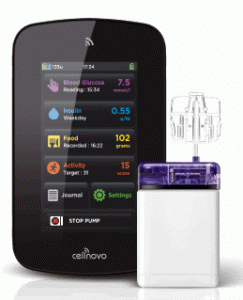All pumped up and no-where to go – hardly! Insulin pumps have gone from being a thing of sci-fi fantasy to being a common-place topic of conversation in clinics across the land. Here we have an overview of news and updates on this fast-moving arena of diabetes kit and care (Oct 2011 insulin pump feature)
Some of us are still getting used to the idea of using an insulin pump – and we’re not even using one yet. Not all of us who do not produce our own (or enough) insulin will need to go on a pump, but if it’s going to help you gain better control over your sugar levels, then at least you can rest assured that things are getting better and better when it comes to technology and diabetes care.
Among the innovations that have taken place recently are two big improvements – patch pumps and CGM (see separate sidebars for further info on these).
Among the new breed of machines, the Cellnovo patch pump claims to be the smallest and most precise yet developed. The touch screen, wireless handset style is instantly familiar to those who have used other mobile devices such as Apple’s iPhone. “Cellnovo has created the first insulin pump that brings innovation and combines form with function, essential qualities in a device that patients can interact with 24/7,” says Dr. Pratik Choudhary, Clinical Lecturer in Diabetes at King’s College London. The technology means that insulin-treated diabetes can now be managed more easily, accurately and intuitively.
As well as ease of use and being tube-free, once the data from the pump is uploaded, your healthcare professional can see it too, so you can get back-up and advice on any changes you may want to make to basal rates and so on. It’s a boon for healthcare workers too — Dr. Mark Evans, Lecturer and Honorary Consultant at the Institute of Metabolic Science at the University of Cambridge says, “The ability to see real-time data of patients who may be hundreds of miles away provides the opportunity to redefine our care model.”
Further news is that the Animas Vibe marks the first integrated product offering from Animas Corporation, makers of high-performance insulin pump technology and Dexcom, a leader in continuous glucose sensing technologies. This becomes only the second insulin pump with CGM available in the UK – the other being Medtronic’s Veo with its own Enlite sensors. An additional feature of the Animas Vibe is that it’s waterproof (the Animas insulin pump is waterproof up to 3.6 metres for 24 hours with the Dexcom G4 transmitter is waterproof at 2.4 metres for 24 hours) and it has a colour screen.
European Approval
The following insulin pumps have all gained European CE approval, which means that they can now be trialled in the UK, though they are not on general release in this country yet.
Receiving CE Mark approval in September for the world’s first ‘mobile diabetes management system’, the Cellnovo Insulin Pump is a diabetes management system built on mobile, wireless technology. The system includes an insulin patch pump, a wireless, touch-screen handset with a built-in blood glucose monitor. The Cellnovo handset wirelessly receives and transmits real-time data to a portal for patients and caregivers to use. This means that patients no longer has to keep meticulous journals – all dosing and blood tests are stored in the handheld and analysis of the data on the colour screen should lead to optimal monitoring and treatment of the condition.
While the continuous delivery provided by an insulin pump allows for better control of blood sugar levels than multiple daily injections, currently available insulin pumps use a reservoir that requires frequent refilling or changing and filling manually using a vial of insulin and syringe. The Pearl Insulin Pump is designed to simplify diabetes care for the more than 500,000 people worldwide that use an insulin pump and those considering insulin pump therapy. Asante Solutions’ Pearl Insulin Pump, which received the CE mark in April 2011, uses an insulin cartridge instead of the traditional reservoir. This should make refilling much quicker and more convenient for users. This pump uses a 300-unit, pre-filled insulin cartridge, simplifying the process of loading the pump and filling the infusion set by reducing the number of steps required, creating a less time-consuming and more convenient process.
The V-Go Insulin Pump is a disposable basal-bolus insulin delivery device providing a continuous baseline of insulin as well as on-demand bolus doses. The microneedle device works for 24 hours and is then thrown away. The V-Go is engineered to simplify basal-bolus insulin therapy and can be used for Type 2 diabetes. The V-Go is small, lightweight, and worn under clothing – you would apply a new V-Go to the skin daily for one 24-hour period. The pump is filled with insulin using a filling accessory — the EZ Fill (included with each monthly supply of V-Go devices). A separate prescription for insulin is required for use with the V-Go. Humalog and NovoLog have both been tested and found safe for use. European CE Mark has been received.
See the full issue of the magazine for our Pump Gallery – an overview of what pump technologies are currently available in the UK today.
MORE INFORMATION — search this site for further insights into the following:
- What is CGM?
- What is a patch pump?
- iPump (contacts)




